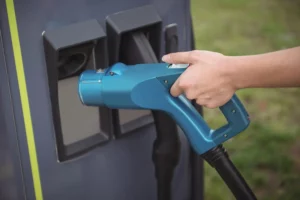
Home / EV Charging News / The Role of Vehicle-to-Vehicle Communication in Electric Cars: Exploring how electric vehicles can communicate with each other to enhance safety, efficiency, and traffic management
In recent years, the automotive industry has witnessed a significant shift towards electric vehicles (EVs) as a sustainable and environmentally friendly alternative to traditional internal combustion engine vehicles. As electric vehicles become more commonplace on our roads, it is essential to consider how emerging technologies can be harnessed to further enhance their capabilities. One such technology is Vehicle-to-Vehicle (V2V) communication, a concept that holds immense potential for improving safety, efficiency, and traffic management in electric cars.
Vehicle-to-Vehicle communication, often abbreviated as V2V, refers to the exchange of information between vehicles in close proximity using wireless communication systems. This technology allows vehicles to share real-time data about their speed, location, acceleration, deceleration, and other vital parameters. By facilitating this seamless exchange of information, V2V communication has the power to transform the way electric cars interact with each other and their environment.
Safety remains a paramount concern for electric vehicles. V2V communication can play a pivotal role in reducing accidents and enhancing road safety. By continuously sharing information about their movements and intentions, electric vehicles equipped with V2V technology can alert nearby vehicles to potential collisions, sudden stops, or hazardous road conditions. This level of awareness can significantly reduce the risk of accidents caused by human errors or unforeseen circumstances.
One application of V2V communication in electric cars is Cooperative Adaptive Cruise Control (CACC). CACC allows vehicles to maintain a safe following distance from the vehicle ahead while also considering the behavior of surrounding vehicles. Through V2V communication, electric cars can adjust their speed and acceleration patterns in a coordinated manner, reducing the likelihood of sudden braking or acceleration events that can lead to traffic congestion.
Traffic congestion is a ubiquitous issue in urban areas. Electric vehicles equipped with V2V communication can help optimize traffic flow. By collectively adapting to traffic conditions, EVs can reduce stop-and-go patterns, minimize traffic jams, and create a smoother overall traffic flow.
Range anxiety, the fear of running out of battery power before reaching a charging station, is a common concern among electric vehicle owners. V2V communication can mitigate this concern by enabling EVs to share information about their battery levels, charging station locations, and energy consumption. With this data, electric cars can make informed decisions about their routes and charging stops, maximizing their efficiency and range.
While V2V communication focuses on interactions between vehicles, it is important to highlight the synergy between V2V and Vehicle-to-Infrastructure (V2I) communication. V2I communication involves interactions between vehicles and roadside infrastructure, such as traffic lights and road signs. By integrating V2V and V2I communication, electric cars can receive real-time information about traffic signals, construction zones, and road closures, allowing them to navigate more efficiently and safely.
As with any technology, V2V communication raises concerns about privacy and security. Transmitting real-time data between vehicles requires robust encryption and authentication mechanisms to prevent unauthorized access or malicious activities. Striking a balance between data sharing for the greater good and ensuring individual privacy remains a challenge that must be addressed as V2V communication becomes more prevalent.
While the potential benefits of V2V communication in electric cars are promising, the road to widespread implementation is not without challenges. One major hurdle is achieving standardization across manufacturers and regulatory bodies. For V2V communication to be effective, all vehicles on the road need to communicate using the same protocols and standards. This requires collaboration among industry stakeholders, government agencies, and international organizations to establish common communication protocols.
The successful deployment of V2V communication also requires adequate infrastructure support. This includes the installation of roadside units and communication beacons that facilitate data exchange between vehicles and the surrounding environment. Government and private sector investment in such infrastructure is crucial to ensure seamless communication and reap the full benefits of V2V technology.
During the transition phase from conventional vehicles to electric cars, there will likely be a mix of vehicle types on the road, including those without V2V capabilities. This poses a challenge in terms of interoperability and effectiveness. Manufacturers and policymakers need to consider strategies for ensuring compatibility and gradual adoption.
While V2V communication is a significant advancement, it is just one piece of the larger puzzle. Vehicle-to-Everything (V2X) communication encompasses a broader range of interactions, including Vehicle-to-Infrastructure (V2I), Vehicle-to-Pedestrian (V2P), and Vehicle-to-Grid (V2G) communication. This expanded scope enables electric cars not only to communicate with each other but also to interact with pedestrians, charging stations, and the power grid, contributing to a holistic and intelligent transportation ecosystem.
Several pilot projects and real-world applications of V2V communication are already underway. These projects provide valuable insights into the feasibility, challenges, and benefits of implementing V2V technology in electric cars. By studying these initiatives, researchers and policymakers can identify best practices and potential areas for improvement, accelerating the integration of V2V communication into the mainstream automotive landscape.
The integration of Vehicle-to-Vehicle communication in electric cars marks a significant step toward a safer, more efficient, and well-managed transportation system. By enabling EVs to communicate with each other and with infrastructure, we can reduce accidents, alleviate traffic congestion, enhance energy efficiency, and extend the driving range of electric vehicles. However, as this technology advances, it is crucial for policymakers, manufacturers, and researchers to collaborate in addressing privacy and security concerns.



